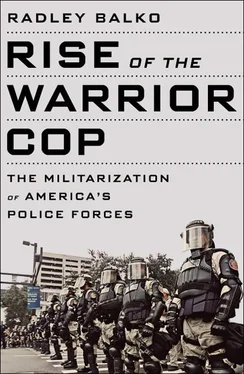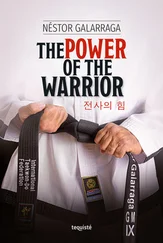“Because of the color of their skin,” Harrelson replied. “Not because they’re black or brown or white. But because they’re blue .”
And so opened the first episode of the ABC drama S.W.A.T., a cheesy, violent (for the time) melodrama from producers Aaron Spelling and Leonard Goldberg. Just eight years earlier, SWAT had been nothing more than a thought bouncing around in Daryl Gates’s head. Now, thanks to a series of high-profile raids climaxing with the 1974 rescue of heiress Patty Hearst from the Symbionese Liberation Army, the concept had entered the mass consciousness. Gates’s idea was now a prime-time network television show with an audience of millions. The show was set in a large, unnamed California city that vaguely resembled Los Angeles. Former LAPD SWAT officer Richard Kelbaugh was a technical adviser for the show. The first episode followed Hondo Harrelson as he recruited Street, Luca, and others for a second SWAT team to be run out of the “Olympic” division of the police department—all while also hunting down the ambushing cop killers (played by a not-at-all-intimidating trio of middle-aged white guys who delivered lines like, Man, I just want to ice some pigs! ). Over the course of the first season, Hondo’s new SWAT unit took on a suspiciously Manson-like cult leader and mass murderer, mob assassins trying to kill a former associate before he could testify before a Senate committee, a militant leftist group that had taken a professional basketball team hostage, an assassin from India sent to kill a US senator by infecting him with plague, terrorists who took a Nobel Prize–winning scientist hostage in a plant loaded with explosives that could eradicate half the city, and—in his toughest battle yet—a pretty young journalist sent to profile Hondo who didn’t really like cops. Cops, she said, are “a necessary evil, but more evil than necessary.”
The first season did well, and ABC ordered a second. Milton Bradley soon put out a S.W.A.T . board game. Kids could take their sandwiches to school in S.W.A.T . lunch boxes. There were S.W.A.T . action figures, View-Master sets, jigsaw puzzles, and die-cast miniatures of the S.W.A.T.-mobile. The show’s theme song, an uptempo instrumental by the funk-disco band Rhythm Heritage, was released as a single in 1976. It sold one million copies and briefly hit number one on the Billboard Hot 100. When the second season of S.W.A.T. was set to premiere, Hondo Harrelson made the cover of TV Guide .
SWAT had hit the pop culture.
AT THE SAME TIME, REAL SWAT TEAMS WERE SPREADING throughout the country. According to a New York Times investigation published in July 1975, by the middle of the 1970s the number of SWAT teams in the United States had grown to around five hundred. Criminologists were concerned. “It is the kind of thing that quickly catches on in police departments because of the pressure to be up to date without any knowledge of what they’re actually getting into,” said Marvin Wolfgang, director of the Center for Studies of Criminology and Criminal Law at the University of Pennsylvania. Someone the Times identified only as “a nationally-known police expert” added, “It reminds me of the nineteen-thirties when some smart salesmen went around the country selling submachine guns to every police department on the theory that they were going to have a shootout with John Dillinger some day.” 86
In its survey of police departments, the paper found that in large cities SWAT teams were usually deployed only in emergency situations and that they tended to perform professionally and skillfully, using their extensive training to deescalate violent situations, often successfully. But smaller towns and suburbs were adopting the SWAT idea too, or at least some version of it. And in many communities SWAT teams and similar units were mostly used to bully protest groups, counterculture enclaves, and minority activists.
Some police officials feared that the SWAT trend, particularly in smaller cities and towns, would succumb to what the philosopher Abraham Kaplan called “the Law of the Instrument”: when you’re carrying a hammer, everything looks like a nail. “There are some cops who want to solve all society’s problems with an M-16,” one police chief told the paper. “Some of these men have lost perspective of their role in society and are playing mental games with firearms…. And if you set yourself up to use heavy firepower, then the danger exists that you will use it at the first opportunity, and over-reaction—the opposite of what the [SWAT] concept is about—becomes a real danger.” 87
Big-city SWAT teams were getting training in paramilitary tactics and weapons, but that training was balanced by an emphasis on negotiation and deescalation and the use of violence only as the last possible option. In the smaller agencies around the country, not only did the SWAT team not get that sort of training, but the teams were staffed by part-timers, usually cops whose full-time jobs were more conventional police work. The risk was that the entire police department could succumb to a culture of militarism. In some quarters, it was already happening. Within a decade, the SWAT proliferation would accelerate. The emphasis on deescalation would all but disappear. Soon, just about every decent-sized city police department was armed with a hammer. And the drug war would ensure there were always plenty of nails around for pounding.

TO INFILTRATE THE SAN JOSE, CALIFORNIA, CHAPTER OF Hell’s Angels, Russ Jones stopped cutting his hair, grew a beard, sported chains and denim, and rode a Harley. He had developed a particular knack for building methamphetamine cases against motorcycle gangs. His undercover getup was so good, in fact, that he’d twice been pulled over and searched, once by the state police and once by one of his colleagues at the San Jose Police Department. The state cop even roughed him up a little. He never did figure out that Jones was a fellow cop. When Jones had accumulated enough evidence to wind down his 1973 investigation of the Hell’s Angels, he cut his hair, trimmed his beard, and then met with a deputy district attorney to sort out what charges to bring against whom.
After several days of planning, Jones held a 4:00 AM briefing the morning of the raids with members of his narcotics team, as well as a few men from the ATF and the FBI. Jones had also specifically asked a lieutenant in the department to send along some uniformed officers to help with the warrants. “We had always sent uniformed officers when we served search warrants, so the suspects clearly and unquestionably knew we were police,” Jones says.
When the San Jose backup detail walked in, Jones was startled. “There were all these guys in SWAT gear. Dark overalls, watch caps, all of that. Daryl Gates’s SWAT team idea had started to spread across the state, but that was my first interaction with ours, which they called MERGE. They looked like they were about to storm a hostage situation.”
Jones approached the lieutenant. “What is this?”
The lieutenant replied, “Our new uniform.”
Jones told the lieutenant to have the MERGE team change into regular uniforms, or he’d just pull some beat cops off the street when he neared the Hell’s Angels hangout. The tactical getups were inappropriate.
“He was angry as hell,” Jones says. Jones had planned to serve the search warrants as he always had—by walking up to the door, knocking, announcing who he was and why he was there, then waiting for someone to answer.
Читать дальше













